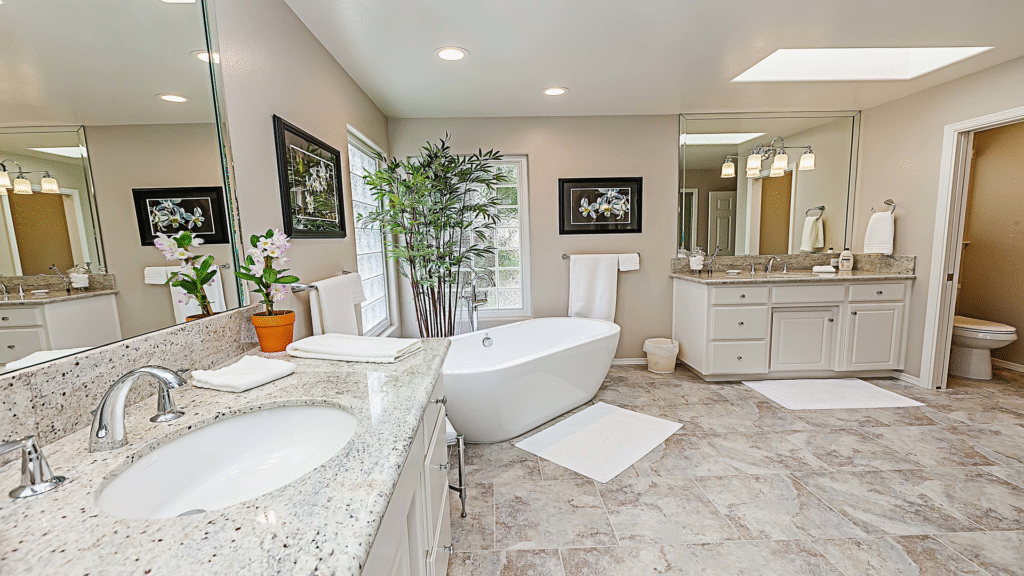Planning a bathroom remodel can be exciting, but before starting, it’s essential to understand local permitting rules. Many homeowners overlook this step, which can lead to delays, fines, or future legal issues. A permission might be necessary, depending on where you are and the extent of the activity.
What Types of Bathroom Remodeling Require a Permit?
Not every bathroom renovation needs a permit. The key factor is whether the work affects structural, plumbing, electrical, or mechanical systems. Here’s a breakdown:
You likely need a permit if you’re:
- Moving or adding plumbing lines (e.g., relocating a toilet or adding a shower)
- Rewiring or upgrading electrical circuits, lighting, or outlets
- Replacing drywall near moisture-prone areas
- Installing or modifying an HVAC system (like a new exhaust fan)
- Changing the layout or removing load-bearing walls
- Converting a half-bath to a full bathroom
You usually don’t need a permit for:
- Painting or wallpapering
- Installing new mirrors or cabinets
- Replacing existing tiles or countertops (as long as no plumbing or structural changes occur)
- Swapping out fixtures like faucets or showerheads without moving pipes
Why Bathroom Remodeling Permits Matter
The purpose of permits is to safeguard homes and guarantee that construction adheres to safety and quality building requirements.
Here’s why it’s critical:
- Safety Assurance
Permits require inspections at various stages. This helps prevent hazards such as water leaks, electrical fires, mold growth, or structural weaknesses. - Legal Compliance
Local governments enforce building codes. Stop-work orders, fines, or mandatory demolition may result from unauthorized work. - Home Resale and Appraisal Value
Future buyers and appraisers often request permit records. Lack of them can lower your home’s value or kill a sale. - Insurance Protection
If an issue arises from unpermitted work, your home insurance may deny coverage for damages or liability claims.
Permit Requirements by State and City
Building codes vary by jurisdiction. Below are general guidelines from key states, but always check with your local office:
| Location | Permit Required? | Where to Check |
| California | Yes – Required for plumbing, electrical, and layout changes | https://www.ladbs.org |
| Texas | Often needed for major plumbing/electrical changes | Varies by city: check Dallas, Houston, Austin websites |
| Florida | Usually required for most remodeling activities due to state code | https://www.miamidade.gov |
| New York City | Yes – Mandatory for structural, plumbing, and electrical modifications | https://www.nyc.gov/buildings |
Some cities offer online permit lookup tools or helplines to guide homeowners. For clarification, it is best to consult a building inspector.
Permit Application Process (Step-by-Step)
- Draft Your Plans
Create a detailed remodeling plan that includes layouts, materials, and specifications for any new fixtures or wiring. - Contact Local Authorities
Visit your city’s Building Department website or office to find the required permit forms and checklists. - Submit an Application
Provide detailed plans, drawings, and sometimes product specs. You’ll pay a permit fee based on project scope. - Schedule Inspections
Most permits require multiple inspections: pre-work, rough-in (for plumbing/electrical), and final. - Receive Final Approval
Once inspectors verify the work meets code, the permit is signed off and closed.
Common Mistakes to Avoid
- Starting work without checking permit requirements: Always confirm before demolition begins.
- Hiring unlicensed contractors: They may skip permit processes to save time or money, risking your project.
- Failing to schedule required inspections: Missing these can invalidate your permit.
- Relying on assumptions: Just because your neighbor remodeled without a permit doesn’t mean it’s legal.
Cost of Bathroom Remodel Permits
Permit fees vary by location and complexity of the job. Here’s a rough guide:
| Permit Type | Estimated Cost |
| Minor Plumbing or Electrical | $50–$200 |
| Full Remodel (Structural + Utilities) | $300–$1,000+ |
| After-the-Fact Permit | $500–$2,000 (with penalties) |
Permit costs may also include plan review fees, inspection fees, and administrative costs.
Resources to Check Permit Requirements
You can verify your local requirements using these resources:
- https://www.permits.com: Centralized platform for permit checks.
- Your local city or county’s website: Look under “Building Department” or “Permit Services.”
- Call 311 (in many cities) or visit your local city hall or permit office.
- Licensed contractors: They often know the permit process well and can assist.
Frequently Asked Questions
Q1: Can I do bathroom remodels myself with a permit?
Yes, many jurisdictions allow homeowners to act as the contractor if it’s their primary residence. However, inspections and codes still apply.
Q2: What happens if I remodel without a permit?
You could face fines, stop-work orders, trouble selling the home, and additional costs to bring the work up to code later.
Q3: How long does it take to get a permit?
Simple permits may be issued within 1–3 days. Larger remodels involving structural changes can take 1–2 weeks or more, especially if plan review is required.
Q4: Does a permit expire?
Yes. Most permits are valid for 6 to 12 months. If work isn’t completed or inspections aren’t passed in time, the permit can expire and may need to be renewed.
Q5: Are permits needed for mobile homes or manufactured homes?
In many cases, yes. These structures often have stricter rules due to fire safety and limited space. Always check with your local authority.
Conclusion
Securing the right permits before remodeling your bathroom is essential to protect your investment, stay compliant with building codes, and avoid legal or financial setbacks. Whether you’re tackling a DIY upgrade or hiring a contractor, always confirm local permit rules. It may seem like a hassle at first, but it saves time and stress in the long run.






